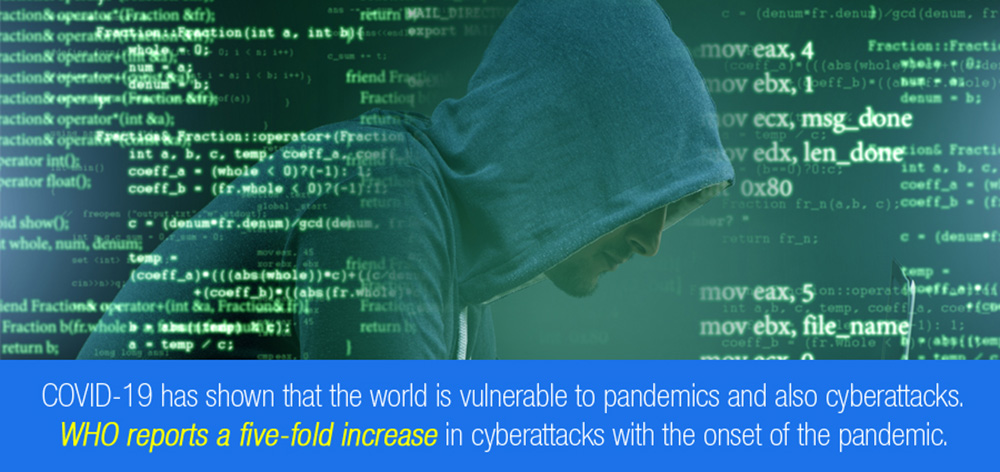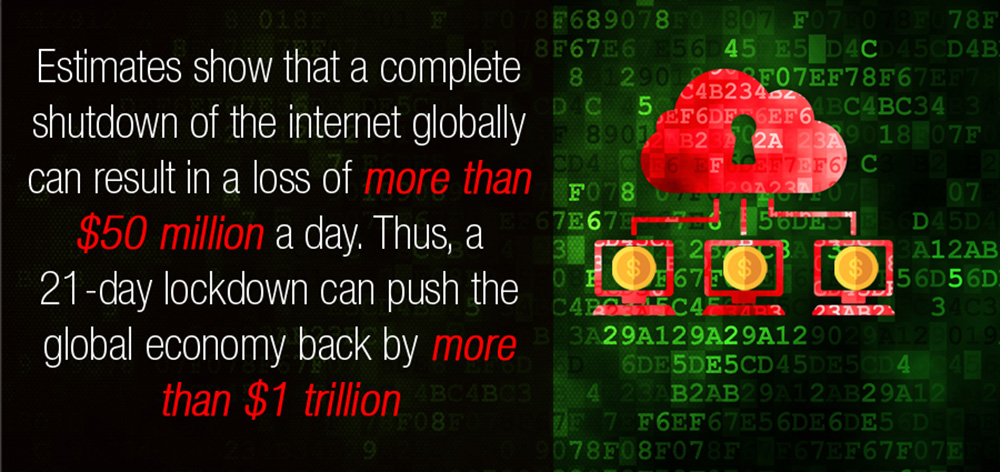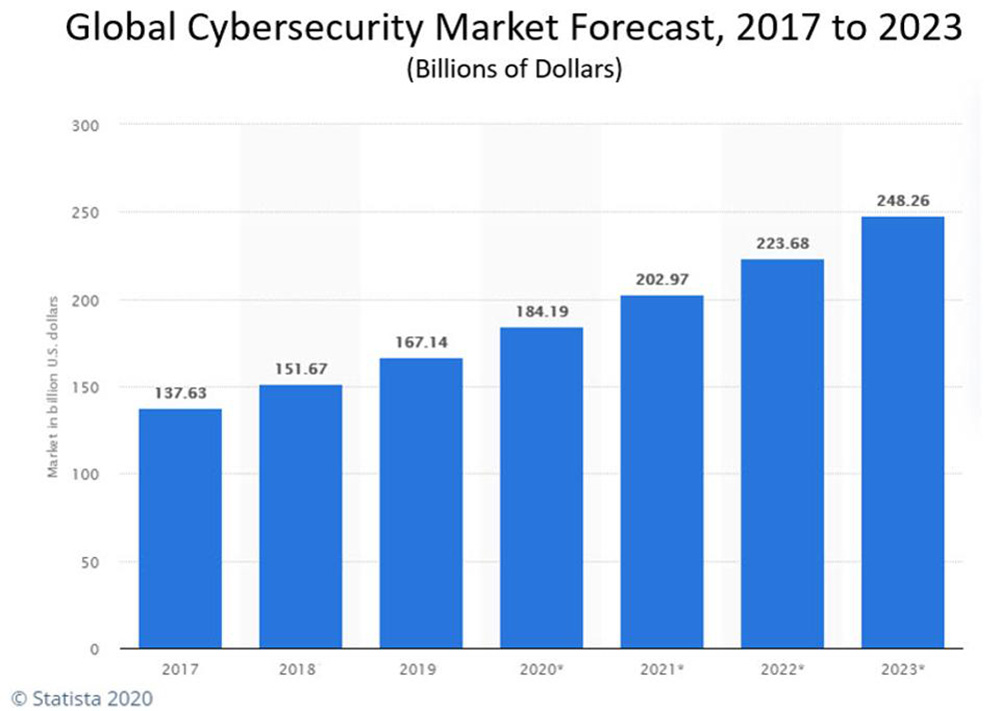No one had ever imagined a global pandemic of COVID-19 scale a few months back. The global pandemic has turned the world on its head. Every country has been affected in some way or the other. The pandemic has shaken the world from its slumber and has driven home the point that the human race can be a more vulnerable lot than previously thought. People are in a state of confusion and disarray on how to deal with the problem. Imagine what will happen if we face a cyberattack on a scale as massive as COVID-19. Let’s call this hypothetical cyberattack as ‘Cyber COVID.’ The thought itself is shuddering. COVID-19 has shown that the world is vulnerable to pandemics and also cyberattacks.

WHO reports a five-fold increase in cyberattacks with the onset of the pandemic. The fallout of a massive cyberattack such as Cyber-COVID can have far-reaching ramifications. However, the coronavirus has also taught the world how to handle such risks.
What Has COVID-19 Taught Us?
COVID-19 has brought the entire world to a standstill. A significant number of people are in a state of lockdown. Countries around the globe have imposed transport restrictions making it impossible for one to travel from one country to another. The economy has been crushed, with millions of industries shutting down businesses. Though it has caused tremendous hardships to people, there is a silver lining to the cloud.
The primary lesson that COVID-19 has taught the world is that it must remain prepared to face such attacks in the future. It has revolutionized history by creating two different eras, the pre-COVID-19 and the post-COVID-19 periods. The world is not going to be the same, and by seeing the increase in the number of virtual workers, one can say that the new ‘normal’ has shifted considerably.
The Threat Of A Cyber COVID – A Massive Cyberattack Of COVID Scale
Imagine if the coronavirus had been a cyberattack. Let’s examine the extent of damage it could have caused and the steps to take to manage the situation.
The reproductive rate (R0) of the coronavirus is a crucial statistic. It determines the number of people it can affect. Reports state that COVID-19 has an R0 between two and three. Thus, one infected person passes the disease to two or three persons. It indicates how fast the virus can spread. The most affected state, New York, had a doubling rate every three days before the lockdown. In comparison, the R0 of a computer virus or a cyber attack is 27 and above. The 2003 Slammer/Sapphire worm had a doubling rate of 8.5 seconds, with the virus attacking more than 75,000 devices in ten minutes. In 24 hours, the number of infected devices grew to more than 10.8 million.
A cyberattack similar to COVID-19 can be a self-propagating attack by a computer virus that exploits zero-day vulnerabilities.

As antivirus solutions would not be immediately available, such cyberattacks can affect devices running on a standard OS. It takes time to identify zero-day attacks. The prime example is the Stuxnet worm that hid in systems for 18 months before affecting them. If such a cyberattack were to impact a social media networking site with sufficient users, it could take around five days to infect a billion devices.
- The economic implications of a cyberattack on the COVID-19 scale can be mind blogging.
A cyber-COVID-like situation can result in the inactivity of millions of devices within a few days. If the cyber coronavirus had similar pathology of COVID-19, the case would be as follows.
- 50% of the network systems would suffer a severe degradation (equivalent to hospitalization for a week).
- 30% of the systems would be asymptomatic (function normally while spreading the virus).
- 15% would require a complete system reinstallation (similar to being on a ventilator).
- 5% of computers worldwide would be rendered inoperable (equivalent to being dead).
Perhaps the only solution would be to enforce a lockdown. Lockdown in the cyber world constitutes the disconnection of the internet, thereby blocking all business communication and financial transactions. It could result in paralyzing social media networks forcing people to resort to using landline phones, snail mail, personal visits, and short-wave radio.

Estimates show that a complete shutdown of the internet globally can result in a loss of more than $50 million a day. Thus, a 21-day lockdown can push the global economy back by more than $1 trillion.
- Recovering from such a situation can be a tremendous challenge.
Considering the number of computer systems in operation today, replacing 5% would require more than 71 million devices. Imagine the time taken to manufacture computer systems on such a massive scale. One also has to contend with logistics issues, patch programs, and reinstallations.
Pointing fingers at nations during the coronavirus pandemic is easy. It would not be the same in the case of cyber-COVID. For example, China is the largest producer of electronics items, smartphones, televisions, and computers in the world today. Blaming such a country for causing cyber-COVID can lead to geopolitical tensions.
How Can The World Manage Such A Situation?
COVID-19 has shown that one should anticipate such a situation and be prepared to manage it accordingly. The best aspect of COVID-19 is that it has created a global awareness of such a risk affecting the world. Here is what one should do to manage a cyber-COVID-like scenario.


- Due Care and Due Diligence: Be prepared for a cyber attack on such a massive scale. To be forewarned is always better than to be forearmed.
- Early Detection & Communication: Early detection, decision-making capabilities, and clarity of communication are two primary virtues to mitigate such potential risks. Any delay in managing the situation can prove disastrous.
- Cybersecurity Awareness, Training & Education: Public awareness is critical to managing such cyber attacks. There should be active cooperation between the different stakeholders. A well-defined cybersecurity policy should help address such cybersecurity challenges.
- Personal Data Protection: Personal data protection should be a priority for all. Organizations can introduce multi-factor authentication for banking transactions and accessing emails, such as using biometrics, or OTP to a registered mobile number.
- Using AI-ML based SIEM solutions: Post-COVID, AI-ML are going to play a significant role in defining cybersecurity strategies. Every network should have adequate security controls in place to manage such cyber risks, and using AI-ML based SIEM solutions can help to a great extent.
- Regulatory compliance: Regulatory compliance is a crucial aspect that every organization should not only adhere to for preventing a cyber-COVID-like attack but also to build a regulator’s trust in your organization’s brand.
- Simulate cyber attack: Conduct regular penetration testing and full-blown attack simulation exercises to determine how well your security teams, tools, and controls perform under and attack. Remember preparedness is planning combined with action.
- Virtual Is Real: COVID-19 has forced people to look to alternatives like Work From Home (WFH) or virtual work environments. Similarly, every organization should have contingency strategies such as a digital rollback, and continuity plans to ensure that the systems keep functioning despite a massive cyberattack.
Final Words
Nobody expected COVID-19 to happen, and that too on such a massive scale. However, the experience with COVID-19 can stand us in good stead. Organizations should be prepared to face a cyber attack of the magnitude of COVID-19 anytime that can paralyze the whole digital ecosystem. The repercussions of such a colossal cyber attack can be devastating, and organizations must implement control measures to prevent it from happening in the future, and be resilient if it happens.
About the author
Dr. Gaddam is a seasoned entrepreneur who launched three successful technology companies in the last seventeen years. Dr. Gaddam’ s greatest accomplishment lies in raising ERP Analysts, Inc. from a two-person organization to eighty-five million firms. ERP Analysts, Inc. has been recognized as one of the fastest-growing companies by Inc. 5000 for ten years, Deloitte Fast 500, & Business First Fast 50 for several years. ERP Analysts is recognized as a “Best Places to Work” in Ohio for several years (erpagroup.com). Dr. Gaddam graduated the Doctor of Management (DM) from Case Western Reserve University, MBA from the Ohio State University, and the Owner/President/Management program (OPM 43) from Harvard Business School. He is the author of the book “Destination Success: Discovering the Entrepreneurial Journey” and also co-author of “Roadmap to Success,” with Deepak Chopra, Ken Blanchard, and other entrepreneurial leaders.





